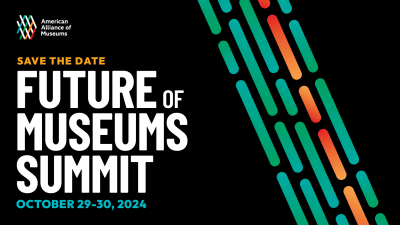This is the fourth and (for now) final installment of our report on the debate held at the Alliance in May regarding the future of museum ethics. In today’s post, James Bradburne, director of the Palazzo Strozzi in Firenze, Italy, makes the case for the resolution:
Resolved: American museums should revisit the Code of Ethics for Museums and relax the restriction on the use of funds from the sale of deaccessioned collections.
The Code of Ethics for Museums states: “Disposal of collections through sale, trade or research activities is solely for the advancement of the museum’s mission. Proceeds from the sale of nonliving collections are to be used consistent with the established standards of the museum’s discipline, but in no event shall they be used for anything other than acquisition or direct care of collections.”
This debate is not about de-accessioning, which American museums consider legitimate, but the use of the funds generated by de-accessioning. We are also not arguing about the elimination of the concern that the well-being of the museum must be the first priority. What is being debated is the need to change the specific wording of the current Code of Ethics in order to allow funds raised by de-accessioning to be used across the full spectrum of the museum’s mission, as determined by its Trustees and Statutes.
Point 1. THE WORDING OF THE CODE OF ETHICS IS CONFLICTED. In the first phrase it rightly asserts that any funds realized by sale of museum assets should be used to further the museum’s mission (rather than paying dividends, taking holidays in Rio etc.). This is clearly a correct ethical stance. However, the last phrase limits the use of the funds solely to one – sometimes secondary – part of the museum’s mission: “acquisition or direct care of collections.” Even if we respect Robert Veach Noble’s definition of the museum’s mission ‘to collect, preserve, study, interpret and exhibit’, which has been superseded by more recent, more vague ICOM definitions, the museum mission – and its stewardship – is not only of collections, but of the historical, scientific and social value their interpretation and exhibition represents. To privilege collection and preservation over interpretation and exhibition seems willful and unwarranted.
Point 2. WHAT IS THE VALUE OF A MUSEUM? The Code assumes that a museum has the responsibility, as a steward of material held in the public trust, to maintain the value of the collections —that total value can be allowed to expand, but never contract. But the notion of value is highly elastic, in both quantity and in quality. The value and nature of museum assets are not stable – they vary with time. As an institution deeply involved with time, the museum cannot exempt itself from history. An Impressionist purchased in Paris in 1903 as an unknown or emerging artist, a purchase that may have represented a small percentage of the museum’s acquisitions budget, acquires a value of millions as the markets increase the value. The costs of insurance make it impossible for the museum to afford keeping the work. However, if the value of the object has increased over time, why should the full sale value be re-invested in the collections? Preserving collections is not the only “public trust” responsibility of museums. We already acknowledge we are responsible for more than merely storing collections. We have equal responsibilities to share our content in meaningful ways that are accessible to a broad swathe of the public. Seen in this way, a museum’s resources are a portfolio that can be distributed across many investments: in collections, staff, facilities, infra-structure and delivery mechanisms. Creating a portfolio that is profoundly unbalanced (for example, investing in the building while understaffing its functions, or maintaining collections without building the capacity to make them accessible to the public) is not acting as a good steward of the resources it holds in the public trust.
Point 3. WHAT IS THE GOVERNING AUTHORITY’S HIGHEST RESPONSIBILITY? It has long been accepted that a governing authority’s primary responsibilities are the duties of care, loyalty, and obedience: Care of the museum’s resources; loyalty to the museum before personal concerns, obedience to the mission. The consequence of the current ethics restriction leads to a potentially self-destructive situation in which, by making maintaining the value of collections the overriding concern, the governing authority neglects its other duties. An institution could collapse entirely at the same time it was using resources, per the Code, to increase or preserve its collections. This is the argument of the cancer cell: the right to grow and thrive at the expense of the host. Our overall responsibility is to maintain the health of the organism, not the individual cells. Many museums have a wide variety of ‘objects’ in their collections: a hands-on science centre, with a mission to foster a working understanding of science, may accomplish that mission through interactive exhibits, paintings, working models etc. For that science centre to sell a painting to build an interactive exhibit – does this violate the Code of Ethics?
SUMMARY ARGUMENT. As with so many issues that museum professionals would like to characterize as being about “standards” this argument is really about difficult and subtle choices regarding rights, responsibilities and stewardship. Museums often want clear guidelines that would relieve them of the need to have messy, uncomfortable conversations. They want a “standard” that there should be term limits for the board, so that they don’t have to ask an underperforming board member to step down. They want there to be a “standard” that the temperature and RH be exactly X or Y, so they don’t have to justify to the board the investment they want to make in environmental controls. For the most messy and uncomfortable issues, they up the ante by characterizing an issue as being not just about standards, but about ethics. Should a museum board member be allowed to exhibit their collection? How handy if one can politely evade the issue that theirs is a subpar collection by saying “ethics say we can’t do that.” If you do accede to an exhibit, much easier to say “you can’t ethically be involved in developing the exhibit or its interpretation [even though you are an amateur expert, steeped in the topic for many years]” rather than negotiating a productive dialog between the board member and the curator, drawing and enforcing reasonable boundaries.
I put to you that the argument regarding ethical restrictions on the use of funds from deaccessioning has taken exactly this lazy path of avoiding a deeper exploration of the issue. What are a museum’s overall stewardship responsibilities to its public? When is a board trying to use deaccessioning as a fast and irresponsible way to raise funds, and when are they making reasoned and reasonable choices about allocation of resources within a museum’s portfolio of stewardship? Why should the fluctuating and largely arbitrary monetary value of a museum’s collections dictate so many of its other choices? Ethics should be boundaries that delineate realms where we can never safely venture, not excuses to avoid exploring unmapped but navigable terrain.
Most importantly of all, perhaps, is deciding what we believe of existing museum governance and governors, and, as a consequence, where we choose to intervene in creating an ethical framework. If we believe that museum governance is inherently flawed, and that trustees cannot be trusted to understand the museum’s mission and act in its best interests, then the correct place to intervene is not in restricting the board’s ability to decide how to use funds, but in strengthening the rules that have an impact on the museum’s governance – how it selects trustees and what informs their decisions. If, on the other hand, we believe that museum governance is robust, and that museum boards and trustees as a rule act in the best interests of their institutions, then it makes no sense to limit their use of funds to a single – and not always central – aspect of the museum’s multi-facetted mission.
Your turn: I encourage you to review my introduction to this series, Sally Yerkovich’s preamble to the Smackdown, and John Simmons arguments against the proposition and then weigh in, below. Which argument do you find most compelling? What reasoning would you advance that has not yet been brought to bear? This is not an academic debate–it is one that my have very real consequences for museums and the standards to which we choose to adhere.
Skip over related stories to continue reading article









Comments